QuantumDot
Harmless

Posts: 7
Registered: 16-4-2019
Member Is Offline
|
|
Nickel chloride?
So over the past week I've been experimenting with making nickel(II) chloride by dissolving fine nickel powder in 30% HCl with some haphazard
additions of 30% H2O2 to speed it up. I got to a nice emerald green solution and once all the powder had disappeared, I stopped additions. I then went
to boil off the water to leave behind the beautiful lime green crystals.
What happened instead was I stupidly left the hotplate unattended and the beaker evaporated to dryness. What was left behind is the yellow-brown
flakes in the first photo. Around the desk were spots of green, which I assume is the hexahydrate. I collected them and dissolved them in a little
distilled water, and got a cyan solution pretty quickly. When I attempted to dissolve the yellow flakes I instead got an opaque brown solution.
So my questions are:
Should I throw away the beaker I used?
What is the yellow/brown flaky stuff?
If it's nickel chloride dihydrate, why didn't it dissolve?
Is it an oxide, despite being yellow?
Guesses, wild or educated, are welcome.
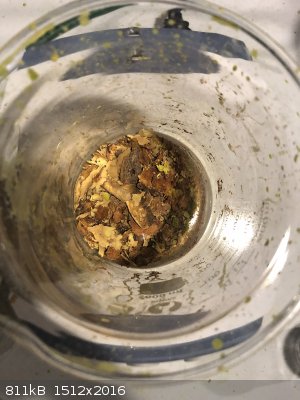 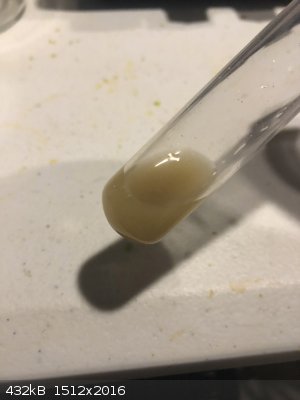 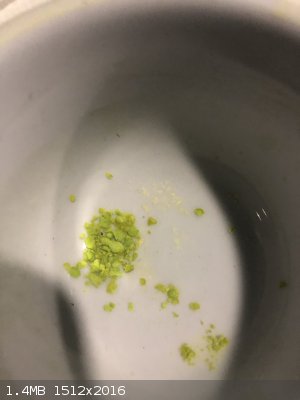 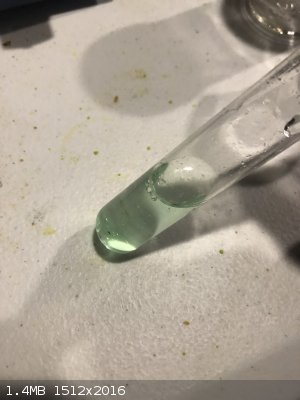
|
|
|
Prepic
Harmless

Posts: 31
Registered: 23-4-2019
Member Is Offline
|
|
I think your best bet is to redissolve everything in your original beacker. Provided your HCl and H2O2 don't contain appreciable amount of any
dissolved solids you can bet whats left there is some form of nickel and should still be relatively pure. In terms of the color produced I am not sure
myself.
|
|
|
macckone
International Hazard
    
Posts: 2159
Registered: 1-3-2013
Location: Over a mile high
Member Is Offline
Mood: Electrical
|
|
My guess would be some kind of oxychloride.
Iron forms a similar oxychloride with prolonged heating of the chloride with the oxide.
I can see this forming from prolonged heating with air.
If it is the oxychloride dissolving it with hydrochloric acid should regenerate the chloride.
Some hydrogen peroxide may speed the reaction.
|
|
|
B(a)P
International Hazard
    
Posts: 1110
Registered: 29-9-2019
Member Is Offline
Mood: Festive
|
|
The colour looks about right for anhydrous nickel chloride, but given the solubility it is probably not. It is probably a mixture of oxides and
anhydrous chloride and other things. Try adding water and heating, if that doesn't work try more HCl and peroxide and see what happens. You should
then be able to repeat and obtain nickel chloride crystals.
When you ask should you throw the beaker away did you mean the contents or the actual beaker? How hot does your hot plate get and did you have it
turned all the way up? Is it borosilicate glass, looks like it from the photo? I imagine it would be fine. Wikipedia says borosilicate can withstand
temperatures up to 500C.
|
|
|
QuantumDot
Harmless

Posts: 7
Registered: 16-4-2019
Member Is Offline
|
|
Quote: Originally posted by Prepic  | | I think your best bet is to redissolve everything in your original beacker. Provided your HCl and H2O2 don't contain appreciable amount of any
dissolved solids you can bet whats left there is some form of nickel and should still be relatively pure. In terms of the color produced I am not sure
myself. |
Quote: Originally posted by macckone  | My guess would be some kind of oxychloride.
Iron forms a similar oxychloride with prolonged heating of the chloride with the oxide.
I can see this forming from prolonged heating with air.
If it is the oxychloride dissolving it with hydrochloric acid should regenerate the chloride.
Some hydrogen peroxide may speed the reaction. |
So redissolving everything in HCl worked fine. That's some interesting stuff on the oxychloride possibility that I hadn't considered. As a side note,
DO NOT underestimate the foaming power of H2O2. Thankfully there was no spill for my tray to catch!
Quote: Originally posted by B(a)P  | The colour looks about right for anhydrous nickel chloride, but given the solubility it is probably not. It is probably a mixture of oxides and
anhydrous chloride and other things. Try adding water and heating, if that doesn't work try more HCl and peroxide and see what happens. You should
then be able to repeat and obtain nickel chloride crystals.
When you ask should you throw the beaker away did you mean the contents or the actual beaker? How hot does your hot plate get and did you have it
turned all the way up? Is it borosilicate glass, looks like it from the photo? I imagine it would be fine. Wikipedia says borosilicate can withstand
temperatures up to 500C. |
It's borosilicate glassware bought from a lab supplier. My hotplate goes to 450C and I only left it for 7-8 minutes so hopefully that's within
acceptable tolerances for the glass.
I've attached a photo of the crystals formed after a more gentle evaporation in a pyrex dish in the sunlight for 2 days. I think stopping the evap by
scraping up the crystals and bottling them before they had a chance to dry out to yellow helped to make a more photogenic material. I even managed to
make some very pretty hexamminenickel(II) chloride with this run. There's a little hydroxide contamination thanks to unreacted nickel making it all
the way through. I think next I'll redissolve the NiCl2 in water and filter it to remove the unreacted metal. (Although ammonia solution seems to
dissolve the hydroxide?)
Thank you everyone for your help.
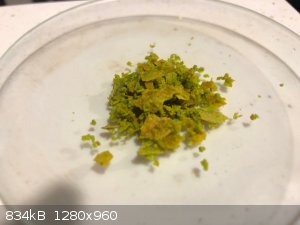 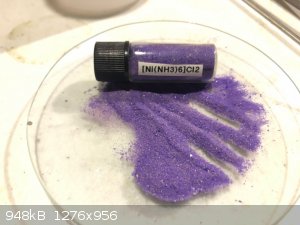
|
|
|
macckone
International Hazard
    
Posts: 2159
Registered: 1-3-2013
Location: Over a mile high
Member Is Offline
Mood: Electrical
|
|
Beautiful.
|
|
|
DraconicAcid
International Hazard
    
Posts: 4278
Registered: 1-2-2013
Location: The tiniest college campus ever....
Member Is Offline
Mood: Semi-victorious.
|
|
Aqueous ammonia will dissolve most nickel salts, including low-solubility ones like the hydroxide.
Please remember: "Filtrate" is not a verb.
Write up your lab reports the way your instructor wants them, not the way your ex-instructor wants them.
|
|
|
woelen
Super Administrator
        
Posts: 7976
Registered: 20-8-2005
Location: Netherlands
Member Is Offline
Mood: interested
|
|
Indeed, the hexamminenickel(II) complex forms soluble salts with most anions. It is a very nice blue/purple complex.
Surprisingly, there is one salt of the hexamminenickel(II) complex which is not soluble in water. That is Ni(NH3)6(ClO4)2. This actually can be used
as a sensitive test for nickel(II). Add a little of a soluble perchlorate salt to the solution (e.g. NH4ClO4 or NaClO4) and then add some ammonia. If
there is nickel present, then you get a purple/blue precipitate of hexamminenickel(II) perchlorate.
|
|
|
Fantasma4500
International Hazard
    
Posts: 1677
Registered: 12-12-2012
Location: Dysrope (aka europe)
Member Is Offline
Mood: dangerously practical
|
|
i just want to add an warning to messing around with nickel salts, i got a nasty tremor lasting me about 24H one time i tried to seperate stainless
steel apart using oxalic acid, and this happened by just spending too many minutes near a pot of insoluble nickel compound in water while the water
was boiling off gently, with ventilation on.
|
|
|
MidLifeChemist
Hazard to Others
  
Posts: 192
Registered: 4-7-2019
Location: West Coast USA
Member Is Offline
Mood: precipitatory
|
|
Quantum Dot, thanks for posting. This is the kind of chemistry that I like to do.
I'm sure it's simple, but would you mind outlining the exact steps you went through to produce the hexamminenickel(II) chloride, including how you
dried it out? I have some NiSO4 and I'd love to try that out sometime.
|
|
|
artemov
Hazard to Others
  
Posts: 181
Registered: 22-8-2018
Member Is Offline
|
|
Hi QD, may I know how did you precipitate and dry the hexaamminenickel chloride without it losing ammonia and change color? Cheers.
|
|
|
QuantumDot
Harmless

Posts: 7
Registered: 16-4-2019
Member Is Offline
|
|
Hi! Sorry for the super late response, but the synthesis was super simple.
I dissolved 5g of nickel chloride in 10ml distilled water, using a few drops of peroxide to speed up the process. Then while heating at 80C and
stirring, I added 10ml of 25% ammonia and the colour changed immediately. I then cooled the solution in an ice water bath to precipitate as much of
the complex as possible, followed by filtration of the remaining liquid. I then simply left the filter paper with the complex to dry on the counter
overnight. Et voila.
[Edited on 20-9-2021 by QuantumDot]
[Edited on 20-9-2021 by QuantumDot]
|
|
|